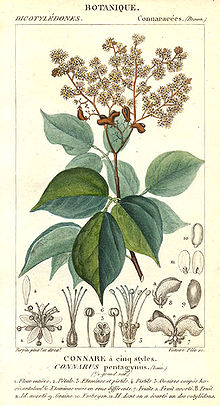Connaraceae
| Connaraceae | ||||||||||||
|---|---|---|---|---|---|---|---|---|---|---|---|---|

Connarus paniculatus , illustration |
||||||||||||
| Systematics | ||||||||||||
|
||||||||||||
| Scientific name | ||||||||||||
| Connaraceae | ||||||||||||
| R.Br. |
The Connaraceae are a family of plants in the order of the wood sorrel (Oxalidales). It is pantropical with about twelve genera and 110 to 200 species.
description

Vegetative characteristics
The types of the family are woody plants: trees, bushes or mostly lianas . The secondary growth in thickness starts from a conventional cambium ring , or abnormally via a concentric cambium ( rourea ).
They can be evergreen or deciduous. The alternate and spirally arranged leaves are divided into a petiole and a leaf blade. The leathery leaf blade is usually pinnate unpaired, but often consists of only one or three leaflets, which usually have a smooth, rarely a lobed edge. The stomata are paracytic, less often cyclocytic, or rarely diacytic. Stipules are missing.
Generative characteristics
The flowers are arranged over bracts in lateral or (pseudo) terminal, racemose or panicle inflorescences . The flowers are mostly hermaphroditic or rarely unisexual. If the flowers are unisexual, then the species are dioeciously segregated ( diocesan ). The small, radially symmetrical to somewhat zygomorphic flowers are (rarely four) mostly five-fold with a double flower envelope . The (four) mostly five sepals are mostly free or at most fused at the base. The (four) mostly five petals are mostly free. There may be a small discus. There are one or mostly two circles with five stamens each, which are free or at most briefly at their base, but not fused with the petals; they are often clearly unequal, with those in the inner circle being longer. Either all of the stamens are fertile or one to five staminodes are present. The pollen grains usually have three, rarely four apertures and are colpate or colporate. There are usually five (one to eight) free, upper carpels . Each carpel contains two mostly orthotropic, bitegmic, crassinucellate ovules .
The follicles are often singly or in pairs to eight together in a collective fruit. The follicles remain closed or open and usually contain only one, rarely two seeds. The seed is usually surrounded by a fleshy, colored sarcotesta and can have an oily endosperm . The seed coat is thick. The embryo is straight.
The basic chromosome numbers are x = 13 or 14.



Systematics and distribution
The Connaraceae family was established in 1818 by Robert Brown in Narrative of an Expedition to Explore the River Zaire , p. 431. The type genus is Connarus L. A synonym for Connaraceae R.Br. is: Cnestidaceae (Raf.) Raf.
It is a pantropical family. The main distribution area is in Africa and in tropical Asia. Some species occur in the subtropics. There are only a few species in the New World .
The Connaraceae family is divided into four tribes and contains about twelve genera with 110 to 200 species:
- Tribus Connareae:
- Connarus L .: It is pantropical with about 80 to 120 species.
- Ellipanthus Hook.f. : The seven or so species are common in the Old World.
- Hemandradenia Stapf : The roughly two species are common in tropical Africa.
-
Burttia Baker f. & Exell : It contains only one type:
- Burttia prunoides Baker f. & Exell : It occurs in Tanzania, Mozambique and Zambia.
- Vismianthus Mildbr. : Of the only two species, one occurs in Tanzania and one in Myanmar.
- Tribus Jollydoreae Lemmens :
-
Jollydora Pierre ex Gilg : It contains only one species:
- Jollydora duparquetiana (Baill.) Pierre : It only occurs in Gabon .
-
Jollydora Pierre ex Gilg : It contains only one species:
- Tribus Manoteae Lemmens :
- Manotes Sol. ex planch. : The only three species are common in tropical Africa.
- Tribe Cnestideae:
- Agelaea Sol. ex planch. : The approximately 15 species are common in tropical Africa and tropical Asia
- Cnestidium Planch. : The four types are common in the Neotropic.
- Cnestis Juss. : The 13 or so species are mainly found in tropical Africa, one species also occurs in tropical Asia.
- Pseudoconnarus Radlk. : The four to five species are common in South America.
- Rourea Aubl. : It is distributed pantropically with about 40 to 100 species.
proof
- The Connaraceae family on the AP website. (Section description and systematics)
- The Connaraceae family at DELTA - Families of flowering Plants by L. Watson & MJ Dallwitz.
- Lingdi Lu & Nicholas J. Turland: Connaraceae in der Flora of China , Volume 9, 2003, p. 435: Online. (Section description and systematics)
- RHMJ Lemmens, FJ Breteler, CCH Jongkind: Connaraceae. In: Klaus Kubitzki (Ed.): The Families and Genera of Vascular Plants - Volume VI - Flowering Plants - Dicotyledons - Celastrales, Oxalidales, Rosales, Cornales, Ericales , 2004, pp. 74-81.
Individual evidence
- ↑ Connaraceae at Tropicos.org. Missouri Botanical Garden, St. Louis
- ↑ Connaraceae in the Germplasm Resources Information Network (GRIN), USDA , ARS , National Genetic Resources Program. National Germplasm Resources Laboratory, Beltsville, Maryland.
